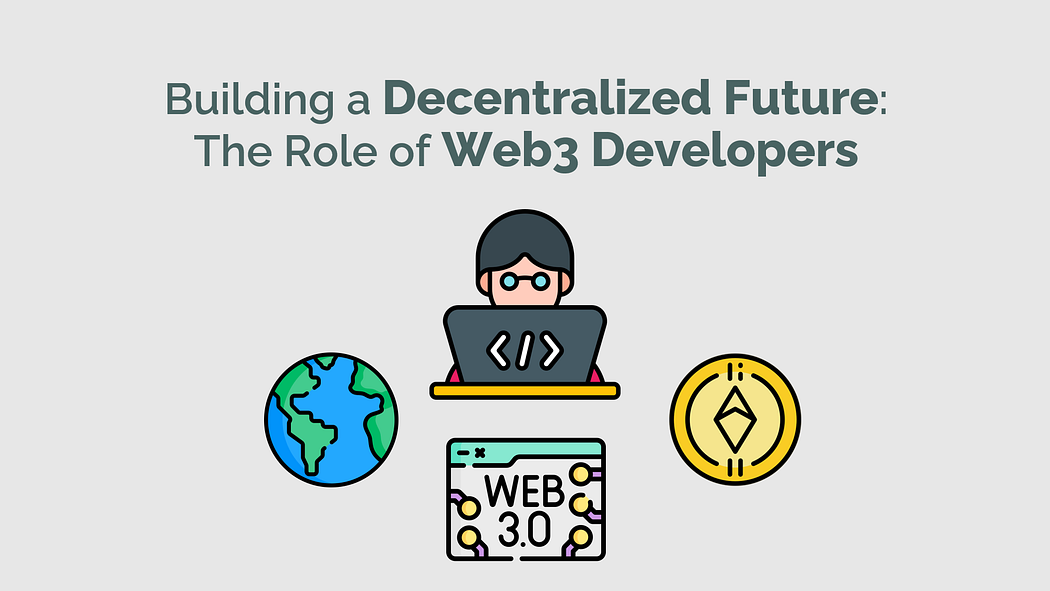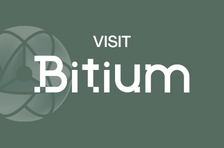Best Blockchain Dev Pathway for 2026: EVM, Rust, or TON?
As we move toward 2026, the blockchain development landscape is evolving rapidly. Protocols are pushing for higher throughput, richer smart-contract capabilities, deeper cross-chain integration, and tighter ties between Web3 and traditional stacks. Meanwhile, the dev tooling in 2025 has matured — offering frameworks, SDKs, infrastructure, and patterns that set the stage. For teams planning new dApps, protocols, or infrastructure through 2026, understanding where the ecosystem is headed and aligning your dev setup accordingly is key. In this article, we’ll map out the roadmap themes for 2026 and finish by outlining how you should align now for what’s coming — covering the EVM, Solana, and TON ecosystems.
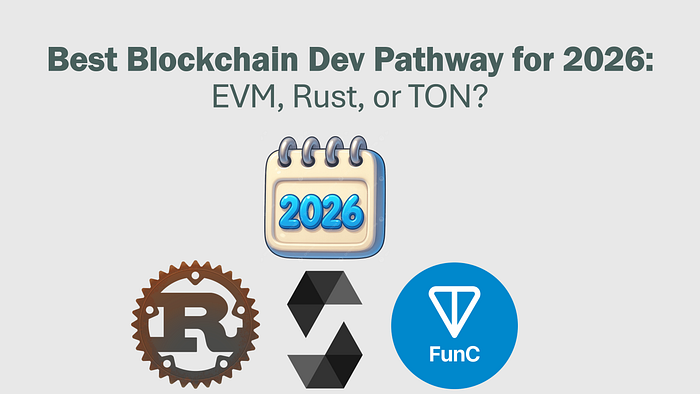
Roadmap Themes for 2026
Based on public protocol roadmap signals and broader ecosystem commentary, here are some key themes:
- Higher throughput & data availability: Protocols anticipate scaling mechanisms enabling 100,000+ TPS-class networks.
- Zero-knowledge proofs & privacy layers: ZK-based rollups, on-chain proofs, privacy-preserving smart contracts will become more standard.
- Cross-chain/interop native: Seamless asset and message flow across chains, and interoperability frameworks will be more embedded.
- Developer/UX focus: Protocols emphasising “remove friction” for devs and users; e.g., in Solana and TON, the tooling and onboarding are improving rapidly.
- Modular infrastructure & app-chains: Building your own rollup/appchain will become more common, supported by Rollup-as-a-Service and tooling.
Your 2026 dev roadmap should reflect these: performance & scale, privacy & ZK, interoperability, better developer experience, and flexible infrastructure.
Best Practice Tools & Dev Setup in 2025
Here are what developers are using now—and should master—to build for 2026 across EVM, Solana, and TON.
Smart Contract Development & Testing
- EVM (Ethereum, etc.): Use Hardhat as your Solidity workhorse. For faster testing/fuzzing, adopt Foundry (Rust-based tooling for EVM). Use OpenZeppelin Contracts for standard modules.
- Solana: Rust remains dominant. Use the Anchor framework for developing “programs” (Solana smart contracts) with macros and safety checks. Also, explore Seahorse (Python-based) and use tools such as the Solana CLI, the Solana Tool Suite, and dev-environment support.
- TON: TON offers its own smart contract languages (FunC, TOLK) and a toolkit. Tools listed under TON Dev Tools include contract verifiers, SDKs, testnet faucets, and no-code SDKs.
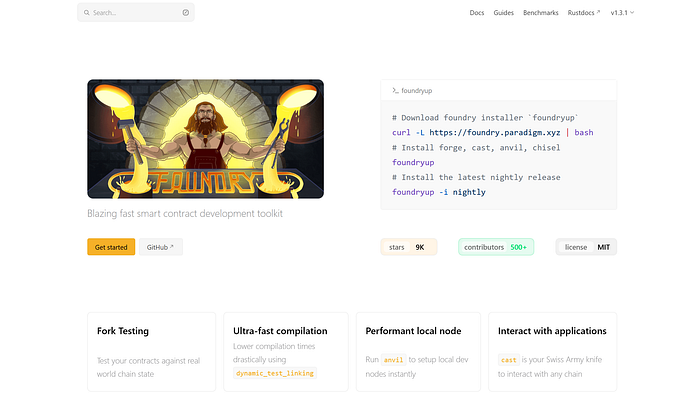
Front-end, Back-end & Integration Tools
- Use ethers.js, Viem, and Wagmi for interacting with EVM chains.
- On Solana, use libraries like
@solana/web3.jsor newer@solana/kit(modular SDK) for front-end and backend logic. - For TON, dev tools include SDKs and APIs listed on the TON Dev Tools site. Use an appropriate wallet adapter or integration for Telegram Mini-Apps (TON is tightly integrated with the Telegram ecosystem).
- RPC/Node providers: pick high-quality endpoints (Solana: Helius, Helios).
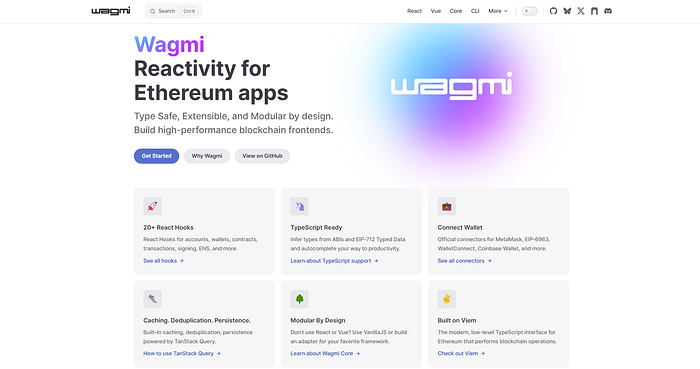
Infrastructure, Chain Set-ups & Appchain Readiness
- If you’re launching or targeting an appchain or rollup in 2026, consider modular infrastructure, e.g., separating execution/data availability layers and supporting cross-chain messages.
- On Solana, you’ll see multi-client architecture, SDK modularisation, and bundling for better build times.
- On TON, you may build “mini-apps” (Telegram Mini Apps) using TON’s integration. TON’s ecosystem updates show active dev growth.
- Ensure your stack is flexible: you might deploy on EVM-compatible, Solana, or TON, depending on your target user base.
EVM vs. Solana Job Market Stats
The Web3 job ecosystem in 2025 offers distinct opportunities depending on your stack and target platform. According to the “State of the Web3 Job Market in 2025” report, Rust (40.8 % of placements) has narrowly outpaced Solidity (35.8 %) as the most sought-after language, driven mainly by high-performance chains like Solana. While less mature than EVM or Solana, TON is ramping up ecosystem support. As of May 2025, its Builders Portal is concentrating resources on DeFi, GameFi, payments, and Telegram-in-app economies.
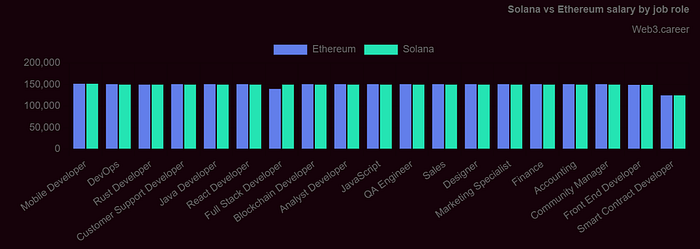
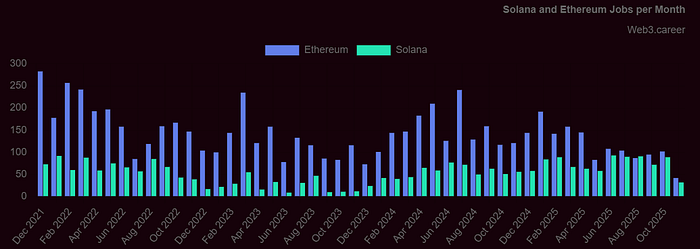
Best Vibe-coding setups for dApps Dev in 2025
The web3 and blockchain development landscape in 2025 is increasingly shaped by “vibe coding” setups, where deeply integrated AI assistants dramatically enhance productivity and lower the barrier to entry. The dominant professional pairing remains VS Code with GitHub Copilot, favored for its seamless integration into the world’s most popular editor and its reliable, context-aware suggestions for Solidity, Rust, and other blockchain languages.
However, newer, AI-first editors like Cursor — often paired with advanced reasoning models like Anthropic’s Claude — are gaining traction, appealing to power users by offering whole-project understanding, conversational refactoring, and complex multi-file edits right in the IDE.
For those focusing on rapid prototyping and visual development, platforms like Lovable are making waves by enabling users to generate full-stack decentralized applications (dApps) from natural language prompts, often outputting clean React/Node.js code that can be easily connected to blockchain backends, abstracting away the initial boilerplate and allowing developers to focus purely on the core decentralized logic.
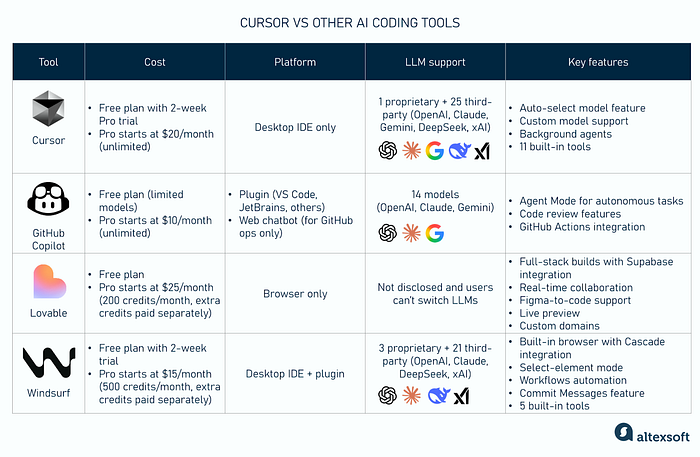
How to Align Now for 2026
- Build for interoperability: Choose SDKs and frameworks that are chain-agnostic or support multiple chains (EVM, Solana, TON).
- Design your contracts for privacy & ZK-readiness: Even if you don’t build ZK circuits now, structure code to support layer-2 or ZK upgrade paths.
- Invest in dev-tooling infrastructure: Get your dev/test stack set up now — including support for multi-chain, devnum tools for Solana and TON.
- Stay ahead of dev culture: For example, incorporate Solana’s improved SDK build processes (reducing build times) and TON’s growing dev ecosystem.
Learn More!
If you would like to explore different fields of the blockchain landscape, check out: Building a Decentralized Future: The Role of Web3 Developers
If you would like to know EVM dev tools in more detail, check out: The Best EVM Development Suite in 2024
Summary
2026 is shaping up as a pivotal year for blockchain development — higher throughput, richer tooling, deeper interoperability, and more modular infrastructure. But to make the most of it, your 2025 dev stack matters. Use the right tools (Hardhat, Foundry, OpenZeppelin for EVM; Anchor, Seahorse for Solana; TON’s SDKs for TON), adopt best practices (micro-patterns, CI/CD, dev UX), and build with future-proofing (interoperability, ZK-readiness, modular architecture).
Best-practice Web3 Development with Bitium
At Bitium Web3 Development Agency, we help teams set up their dev stacks, architect modular appchains across EVM/Solana/TON, integrate cutting-edge tooling, and build “vibe-ready” codebases that not only launch now but scale into 2026. Let us help you turn your roadmap into code.
Listen To The Article

Black Friday 30%
Offer

